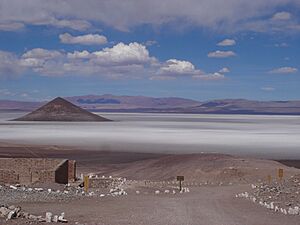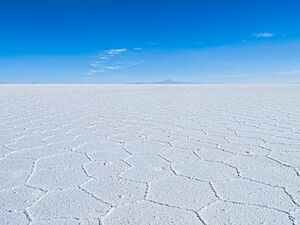Salt pan (geology) facts for kids
Natural salt pans or salt flats are huge, flat areas of land covered with salt and other minerals. They often shine bright white under the sun! You usually find these amazing natural formations in deserts. They are different from man-made salt evaporation ponds, which people create to collect salt.
A salt pan forms when a body of water, like a lake or pond, completely dries up. This happens in very dry places, like deserts, where more water evaporates into the air than falls as rain. If the water cannot soak into the ground, it stays on the surface. As the water evaporates, it leaves behind tiny mineral particles, mostly salts, that were dissolved in the water. Over thousands of years, these minerals build up on the surface, creating the shiny white landscape we see.
Even though they look solid, salt pans can sometimes be tricky and dangerous. The hard crust of salt on top can hide soft, deep mud underneath. This muddy trap, called a quagmire, can be strong enough to swallow a vehicle! For example, during World War II, some parts of the Qattara Depression in the eastern Sahara Desert had these dangerous mud traps, which acted as natural barriers.
Contents
Famous Salt Pans Around the World
Bonneville Salt Flats, USA
The Bonneville Salt Flats are located in Utah, in the western United States. This famous salt pan is known worldwide as a place where many incredible land speed records have been set by special cars and motorcycles.
Etosha Pan, Namibia
Another impressive example is the Etosha pan, found within the Etosha National Park in Namibia, Africa. This vast, shimmering white pan is a key feature of the park.
Salar de Uyuni, Bolivia
The Salar de Uyuni in Bolivia is the largest salt pan on Earth! It's an enormous, flat area that looks like a giant mirror when covered with a thin layer of water. This salt pan holds a huge amount of lithium, a metal used in batteries for phones and electric cars. As of 2024, Bolivia had about 22% of the world's known lithium resources, with most of it in the Salar de Uyuni. Because it's so large, flat, and has clear skies, the Salar de Uyuni is also a perfect spot for checking and adjusting the altimeters on Earth observation satellites. These instruments measure height from space.
Rann of Kutch, India
In India, parts of the Rann of Kutch change with the seasons. During the wet season, it becomes a salt marsh (a wetland with salty water). But in the dry season, it transforms into a vast salt pan.
Chalbi Desert, Kenya
Salt flats can also be found in Kenya. The Chalbi Desert in North Horr Sub County, Marsabit County, is one such place. In the language of the local Gabra people, "Chalbi" means "bare, salty area," which perfectly describes this unique landscape.
Related Landforms




